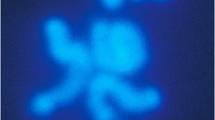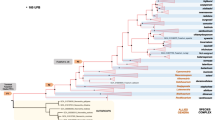Abstract
A comparative genomic approach was used to study the mating type locus and the gene cluster involved in toxin production (fumonisin) in Fusarium proliferatum, a pathogen with a wide host range and a complex toxin profile. A BAC library, generated from F. proliferatum isolate ITEM 2287, was used to identify chromosomal regions flanking the mating type locus and the gene cluster involved in the biosynthesis of fumonisin. These regions were sequenced and compared with corresponding sequences in other ascomycetes. The results demonstrated that the level of synteny between ascomycetes can vary greatly for different genomic regions and that the level of similarity of genes within a region can also fluctuate strongly. Synteny was found in the regions flanking the mating type idiomorph among ascomycetes that supposedly diverged 280 million years ago. The fumonisin gene clusters of F. proliferatum and F. verticillioides were completely syntenic but absent in F. graminearum. The regions flanking the fumonisin gene clusters were highly dissimilar between F. proliferatum and F. verticillioides, whereas they formed a continuous region in F. graminearum. This indicates that the fumonisin gene cluster has been inserted at different genome locations in both species. Surprisingly low similarity was found between the corresponding genes within the fumonisin cluster of F. proliferatum and F. verticillioides, compared to other genomic sequences indicative for two independent acquisition events from distinct genetic sources. The results demonstrate the power of comparative genomics for gene annotation and for studies on the evolution of genes, gene-clusters and species.
Similar content being viewed by others
References
Arie T, Christiansen SK, Yoder OC and Turgeon BG (1997) Efficient cloning of ascomycete mating type genes by PCR amplification of the conserved MAT HMG box. Fungal Genetics and Biology 21: 118-130
Berbee ML and Taylor JW (1993) Dating the evolutionary radiations of the true fungi. Canadian Journal of Botany 71: 1114-1127
Bonfield JK, Smith KF and Staden R (1995) A new DNA sequence assembly program. Nucleic Acids Research 24: 4992-4999
Bottalico A (1998) Fusarium diseases of cereals: Species complex and related mycotoxin profiles. European Journal of Plant Pathology 80: 85-103
Bruchez JJP, Eberle J and Russo VEA (1993) Regulatory sequences in the transcription of Neurospora crassa genes: CAAT box, TATA box, introns, poly(A) tail formation sequences. Fungal Genetic Newsletter 40: 89-96
Cozijnsen AJ and Howlett BJ (2003) Characterisation of the mating-type locus of the plant pathogenic ascomycete Leptosphaeria maculans. Current Genetics 43: 351-357
Desjardins AE and Plattner RD (2000) Fumonisin B1-nonpro-ducing strains of Fusarium verticillioides cause maize (Zea mays) ear infection and ear rot. Journal of Agricultural and Food Chemistry 48: 5773-5780
Desjardins AE, Plattner RD, Nelsen TC and Leslie JF (1995) Genetic analysis of fumonisin production and virulence of Gibberella fujikuroi mating population A (Fusarium moniliforme) on maize (Zea mays) seedlings. Applied and Environmental Microbiology. 61: 79-86
Desjardins AE, Proctor RH, Bai GH, McCormick SP, Shaner G, Buechley G and Hohn TM (1996) Reduced virulence of trichothecene-non producing mutants of Gibberella zeae in wheat field tests. Molecular Plant Microbe Interactions 9: 775-781
Elmer WH (1995) A single mating population of Gibberella fujikuroi (Fusarium proliferatum) predominates in asparagus fields in Connecticut, Massachusetts, and Michigan. Mycologia 87: 68-71
Gelderblom WCA, Kriek NPJ, Marasas WFO and Thiel PG (1991) Toxicity and carcinogenicity of the Fusarium moniliforme metabolite, fumonisin B-1, in rats. Carcinogenesis 12: 1247-1252
Glass NL and Donaldson GC (1995) Development of primer sets designed for use with the PCR to amplify conserved genes from filamentous ascomycetes. Applied and Environmental Microbiology 61: 1323-1330
Goodwin SB, Waalwijk C, Kema GHJ, Cavaletto JR and Zhang G (2003) Cloning and analysis of the mating-type idiomorphs from the barley pathogen Septoria passerinii. Molecular Genetics and Genomics 269: 1-12
Howard PC, Eppley RM, Stack ME, Warbritton A, Voss KA, Lorentzen RJ, Kovach RM and Bucci TJ (2001) Fumonisin B-1 carcinogenicity in a two-year feeding study using F344rats and B6C3F(1) mice. Environmental Health Perspectives 109 (Suppl. 2): 277-282
Kim UJ, Birren BW, Slepak T, Mancino V, Boysen C, Kang HL, Simon MI and Shizuya H (1996) Construction and characterization of a human bacterial artificial chromosome library. Genomics 34: 213-218
Larkin RP and Fravel DR (1999) Mechanisms of action and dose-response relationships governing biological control of fusarium wilt of tomato by non-pathogenic Fusarium spp. Phytopathology 89: 1152-1161
Moretti A, Logrieco A, Bottalico A, Ritieni A, Fogliano V and Randazzo G (1997a) Diversity in beauvericin and fusaproliferin production by different populations of Gibberella fujikuroi (Fusarium section Liseola). Sydowia 48: 44-56
Moretti A, Logrieco A, Doko B, Frisullo S, Visconti A and Bottalico A (1997b) Fusarium proliferatum from asparagus, in Italy: Occurrence, fertility and toxigenicity. Cereal Research Communications 25: 785-786
Munkvold G, Stahr HM, Logrieco A, Moretti A and Ritieni A (1998) Occurrence of fusaproliferin and beauvericin in Fusarium-contaminated livestock feed in Iowa. Applied and Environmental Microbiology 64: 3923-3926
Ocamb CM, Juzwik J and Martin FB (2002) Fusarium spp. and Pinus strobus seedlings: Root disease pathogens and taxa associated with seed. New Forests 24: 67-79
O'Donnell K, Kistler HC, Tacke BK and Casper HH (2000a) Gene genealogies reveal global phylogeographic structure and reproductive isolation among lineages of Fusarium graminearum, the fungus causing wheat scab. Proceedings of the National Academy of Sciences 97: 7905-7910
O'Donnell K, Nirenberg HI, Aoki T and Cigelnik E (2000b) A multigene phylogeny of the Gibberella fujikuroi species complex: Detection of additional phylogenetically distinct species. Mycoscience 41: 61-78
Proctor RH, Brown DW, Plattner RD and Desjardins AE (2003) Co-expression of 15 contiguous genes delineates a fumonisin biosynthetic gene cluster in Gibberella moniliformis. Fungal Genetics and Biology 38: 237-249
Proctor RH, Desjardins AE, Plattner RD and Hohn TM (1999) A polyketide synthase gene required for biosynthesis of fumonisin mycotoxins in Gibberella fujikuroi mating population A. Fungal Genetics and Biology 27: 100-112
Proctor RH, Hohn TM and McCormick SP (1995) Reduced virulence of Gibberella zeae caused by disruption of a trichothecene toxin biosynthetic gene. Molecular Plant Microbe Interactions 8: 593-601
Rheeder JP, Marasas WFO, Thiel PG, Sydenham EW, Shephard GS and Van Schalkwyk DJ (1992) Fusarium moniliforme and fumonisins in corn in relation to human oesophageal cancer in Transkei. Phytopatholology 82: 353-357
Seo JA, Proctor RH and Plattner RD (2001) Characterization of four clustered and co-regulated genes associated with fumonisin biosynthesis in Fusarium verticillioides. Fungal Genetics and Biology 34: 155-165
Tatusova TA and Madden TL (1999) BLAST 2 SEQUENCES, a new tool for comparing protein and nucleotide sequences. FEMS Microbiology Letters 174: 247-250
Waalwijk C, Mendes O, Verstappen ECP, de Waard MA and Kema GHJ (2002) Isolation and characterization of the mating-type idiomorphs from the wheat septoria leaf blotch fungus Mycosphaerella graminicola. Fungal Genetics and Biology 35: 277-286
Wang H, Wei H, Ma J and Luo X (2000) The fumonisin B1 content in corn from North China, a high-risk area of oesophageal cancer. Journal of Environmental Pathology, Toxicology and Oncology 19: 139-141
Waterston RH, Lindblad Toh K, Birney E, Rogers J, Abril JF, Agarwal P, Agarwala R, Ainscough R, Alexandersson M, An P, Antonarakis SE, Attwood J, Baertsch R, Bailey J, Barlow K, Beck S, Berry E, Birren B, Bloom T, Bork P, Botcherby M, Bray N, Brent MR, Brown DG, Brown SD, Bult C, Burton J, Butler J, Campbell RD, Carninci P, Cawley S, Chiaromonte F, Chinwalla AT, Church DM, Clamp M, Clee C, Collins FS, Cook LL, Copley RR, Coulson A, Couronne O, Cu. J, Curwen V, Cutts T, Daly M, David R, Davies J, Delehaunty KD, Deri J, Dermitzakis ET, Dewey C, Dickens NJ, Diekhans M, Dodge S, Dubchak I, Dunn DM, Eddy SR, Elnitski L, Emes RD, Eswara P, Eyras E, Felsenfeld A, Fewell GA, Flicek P, Foley K, Frankel WN, Fulton LA, Fulton RS, Furey TS, Gage D, Gibbs RA, Glusman G, Gnerre S, Goldman N, Goodstadt L, Grafham D, Graves TA, Green ED, Gregory S, Guigo R, Guyer M, Hardison RC, Haussler D, Hayashizaki Y, Hillier LW, Hinrichs A, Hlavina W, Holzer T, Hsu F, Hua A, Hubbard T, Hunt A, Jackson I, Jaffe DB, Johnson LS, Jones M, Jones TA, Joy A, Kamal M and Karlsson EK (2002) Initial sequencing and comparative analysis of the mouse genome. Nature 420: 520-562
Yun SH, Arie T, Kaneko I, Yoder OC and Turgeon BG (2000) Molecular organization of mating type loci in heterothallic, homothallic, and asexual Gibberella/Fusarium species. Fungal Genetics and Biology 31: 7-20
Author information
Authors and Affiliations
Corresponding author
Rights and permissions
About this article
Cite this article
Waalwijk, C., van der Lee, T., de Vries, I. et al. Synteny in Toxigenic Fusarium Species: The Fumonisin Gene Cluster and the Mating Type Region as Examples. European Journal of Plant Pathology 110, 533–544 (2004). https://doi.org/10.1023/B:EJPP.0000032393.72921.5b
Issue Date:
DOI: https://doi.org/10.1023/B:EJPP.0000032393.72921.5b




